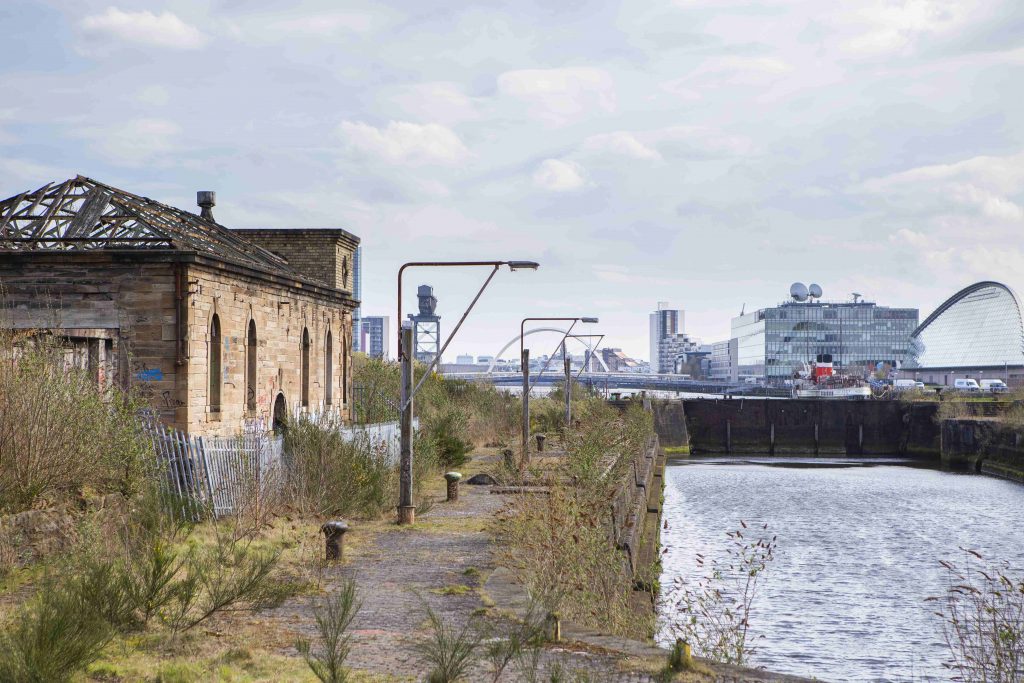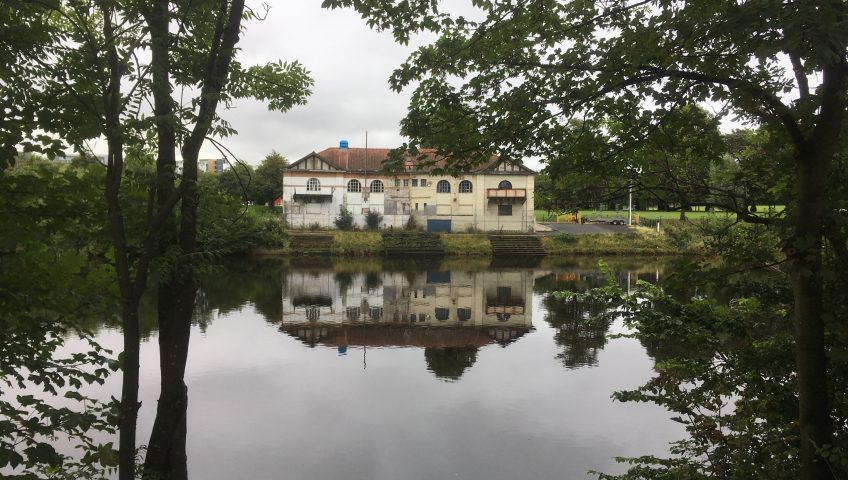Summary
Our residency was constructed as an intensive cultural mapping process. The objective: to support our visiting artists to uncover as much as possible in the history, heritage, landscape, people, story, myths, legends, architecture and memory of Govan and its context within Glasgow.
Our overall aim was to start with the big picture: like a drone eye in the sky overlooking the Strathclyde valley with the scope of the whole River Clyde gradually zooming in to look closely at identified people and places of interest.
Within the overall aim, we had several objectives:
– to take the needs/interests of each participating artist into account: ensuring that the people, places, history, sites, locations and story would match with the unique skillset, interests and aspirations of each of the artists.
– to make sure that the people, groups and local artists introduced to our guests would be interested, inspired and excited by what working with an internationally acclaimed artist on a high profile European project might do to support their own work here in Govan.
– to deliver the scheduled urban lab at the end of the week as an important event in its own right. With two residencies and two international urban lab opportunities for Govan, we decided the first lab should focus on artists and practice while the second should be more strategic and explore how the artists and practice can influence planning and policy.
– to build in time for reflection, evaluation, artists own time to explore their own ideas further, networking and relationship building.
Our programme included the renowned Glasgow mural trail,
the historic West Boathouse on Glasgow Green (en.wikipedia.org/wiki/Glasgow_Green ), a row upstream to see the city from the river) and a cycle on the tow paths and Cuningar Loop to experience the River from its banks (www.visitscotland.com/info/see-do/cuningar-loop-woodland-park-p1498501).
The history making Kinning Park Complex (subject of a community buy out) was our base for meals, a film screening that included Jonas Mysterand’s first piece (https://vimeo.com/357175263) and an afternoon of meeting local artists like Gaynor Milne (www.linkedin.com/in/gaynor-milne-78b73588/) Paul MacAlinden (www.glasgowbarons.com) and Richard Walker (richardwalker.info/CV) as well as a huge variety of community organisations including.
Iain McGillivray of Clyde Docks Preservation Initiative hosted a “Walk to the Docks” where we heard the story of the 8 year campaign to save Govan’s iconic Graving Docks (www.cdpi.org.uk/) and the successful overturning of a plan to build 750 high rise flats on the A listed site. We visite the disused ex Harland and Woolff shed on Clydebrae Street (govanshed.co.uk) which is now an emerging cultural hub of Govan with artists/artizan/craft workshop units in the smaller spaces and a huge space used by theatre companies, film studios as well as by local community groups for pageants and we visited the Riverside Hall: a very well used and long standing community centre for Govan, holding clubs, classes, groups and community meals. (www.getintogovan.com/projects/riverside-hall/).
With lunch back at the Kinning Park Centre, we spent the afternoon sharing food and experiences with various local artists like Gaynor Milne (www.linkedin.com/in/gaynor-milne-78b73588/) Paul MacAlinden (www.glasgowbarons.com) and Richard Walker (richardwalker.info/CV) as well as a huge variety of community organisations including Govan HELP (www.govanhelp.org/) and Govan Community Organisation www.govancommunityproject.org.uk/
Our main question to Martin Avila and the group who now own and are rejuvenating the Kinning Park Complex was how can artists and the communities they are serving, work in declined urban environments, help to raise regenerate but not become subject to gentrification? Are the artists simply part of the problem and are buildings like KPC going to become inaccessible to the communities who fought for them?
Martin and his team are of course determined that will never happen with Kinning Park Complex.
Visits in Central Govan included Elder Park, (friendsofelderpark.wordpress.com/), Moogety Garden, that supports community based learning and growing (elderpark.org/your-community/projects/moogety-foods-moogety-food-hub-moogety-garden/), Fairfield Heritage (www.fairfieldgovan.co.uk/heritage) and Govan Old Church to see the Govan Stones (www.thegovanstones.org.uk/).
Our journey continued across the River Clyde on Govan’s free ferry that runs during the summer, taking people between Govan and Partick – two areas which were historically one borough. Water Row has been a fordable crossing point since Neolithic times (www.bbc.co.uk/news/uk-scotland-scotland-business-13841775) and on the other bank, we met Glasgow Coastal Rowing Club (rowglasgow.org.uk/) befoore visiting the Riverside Museum (www.clydewaterfront.com/projects/greater-govan–glasgow-harbour/leisure/riverside_museum) which has won accolades for its popular programme and volunteer guides who are able to share lived experiences with the visitors (https://en.wikipedia.org/wiki/Riverside_Museum)
A quick tour of the Glenlee or ‘Tall Ship’, restored by the Clyde Maritime Trust (thetallship.com/index.aspx) preceded our journey back across to the Govan side of the Clyde, to visit the GalGael Trust (www.galgael.org/) for wonderful meal with a ceilidh (everyone contributing a song to the occasion)
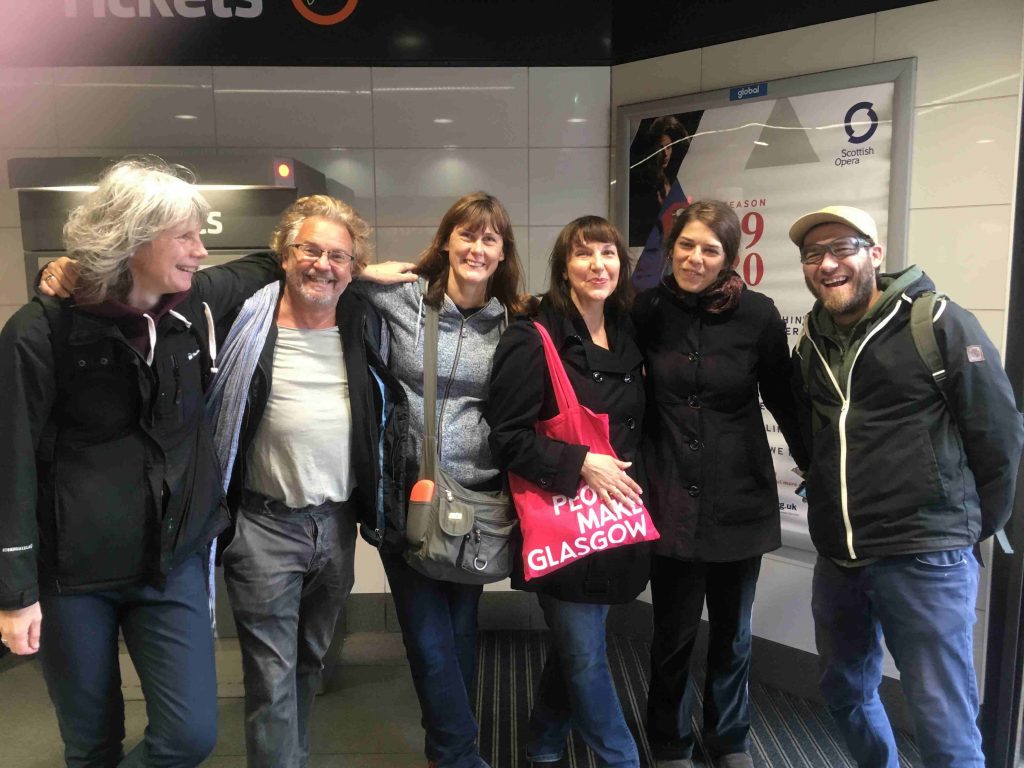
Memory of Water’s first international urban lab in Govan (the second one is scheduled for June 2020) took place in Film City (www.filmcityglasgow.com/). Our urban lab was a hugely successful full day of exploration of the main themes of Memory of Water and the evening of Friday the 6th September we were afforded a great honour as we were hosted by the Lord Provost of Glasgow, Eva Bolander who is taking a personal interest in our Memory of Water project.
The morning of Saturday 7th September was our evaluation meeting in our home base flat with Helen Kyle, the hero of the Kinning Park sit in where the artists shared their initial responses to what they have seen in Govan and the ideas that are beginning to take shape towards the production week in June 2020.
Our final shared activity on Saturday was joining tsBeall and the Strong Women of the Clydeside team on one of their celebrated art walks. We walked in the footsteps of Mary Barbour, Isabella Elder, Helen Kyle and others: visiting the key spaces and places associated with their memories and achievements followed bya final meal together in the Amethyst,
Conclusions and learning
The learning has only just begun from our process in Govan but already there are some emerging findings:
– The threat of gentrification is as big a threat in Govan as it is in other European cities. Already, much of the Clyde has been built on with high rise homes and loss of industrial infrastructure. There are a few locations left, with Govan Graving Docks being one of them. What will happen to them and can the artistic interventionism make any real, tangible impact.
– We noticed the dialogue about arts and culture tends to be focused on “arts development” rather than cultural planning with Glasgow City Council officers and we wonder how we can influence that thinking. Without full distinction of the differences, it will remain a struggle for the Govan Hill Baths and the Kinning Park Complexes as well as the Govan Graving Docks.
– The question of Governance is a fascinating area that is opening up from our Govan deliberations. There is a big focus on artist collaboratives and artist collectives across Europe in the 21st Century. However, it seems to be the structure that has both artists and local people in the management and driving seats that have the most power and sustainability.
These are just three of the key themes that are emerging from our initial thinking. All themes to be explored further and to bring to our thinking when we next meet in Gdansk, Poland in October.
The Legacy
Already, in Govan, the ripple effects from being part of a high profile collaborative European project are being felt. Our project has been mentioned in two national news letters: Local People Leading (edited by Angus Hardie who contributed to our Urban Lab) ran a piece on the impact of artists in communities when they are working WITH communities inspired by his experience in Govan. The Social Enterprise network linking organisations focussed on Health and Wellbeing ran a piece on our interventions with an inquiry about the impact this kind of creative and cultural activity has on both mental and physical health.
Finally, and with great excitement, we are delighted to have been invited to exhibit the initial outputs from Memory of Water in the Scottish Parliament during the return week in June 2020. This is on the one hand a huge opportunity and on the other, a nerve wracking prospect as we need to capitalise on the possibilities, we need to create something with impact, quality and outputs and we need to inspire debate around it in the parliament.
These topics will be subjects of our deliberations in our planning meetings going forward.
Govan Research Residency 2-8 September, 2019.
Introduction
Our residency was constructed as an intensive cultural mapping process. The objective: to support our visiting artists to uncover as much as possible in the history, heritage, landscape, people, story, myths, legends, architecture and memory of Govan and its context within Glasgow.
Aims and Objectives
Our overall aim was to start with the big picture: like a drone eye in the sky overlooking the Strathclyde valley with the scope of the whole River Clyde gradually zooming in to look closely at identified people and places of interest.
Within the overall aim, we had several objectives:
– to take the needs/interests of each participating artist into account: ensuring that the people, places, history, sites, locations and story would match with the unique skillset, interests and aspirations of each of the artists.
– to make sure that the people, groups and local artists introduced to our guests would be interested, inspired and excited by what working with an internationally acclaimed artist on a high profile European project might do to support their own work here in Govan.
– to deliver the scheduled urban lab at the end of the week as an important event in its own right. With two residencies and two international urban lab opportunities for Govan, we decided the first lab should focus on artists and practice while the second should be more strategic and explore how the artists and practice can influence planning and policy.
– to build in time for reflection, evaluation, artists own time to explore their own ideas further, networking and relationship building.
Arrival and Induction
Sunday and Monday were arrival and gathering days but we tried to make use of every second of available time. Early arrival, Siegfried Vynk, (spraycan artist from Ostend) wanted to explore some of the renowned mural street art for which Glasgow is now famous. We wanted to share some traditional Scottish food with our guests so of course, we sampled a Glaswegian curry in the Village Curry House.
Even our residential arrangements were designed to enhance the learning as we had our main home living base and team hub in the home of Helen Kyle, Director of Scotland in Europe, community activist and curator, who initiated the campaign to save the Kinning Park Complex (KPC). KPC is one of the first examples of an urban community buy out in Scotland (https://www.pressreader.com). Our welcome meal and induction meeting took place in Helen’s home (our temporary home for the week) with haggis, neeps, tatties, crannochan, and Robert Burns. Helen shared story after story with the group and her grandson joined our technical and production team, becoming an invaluable film assistant when the Fablevision Studios camera operator took ill.
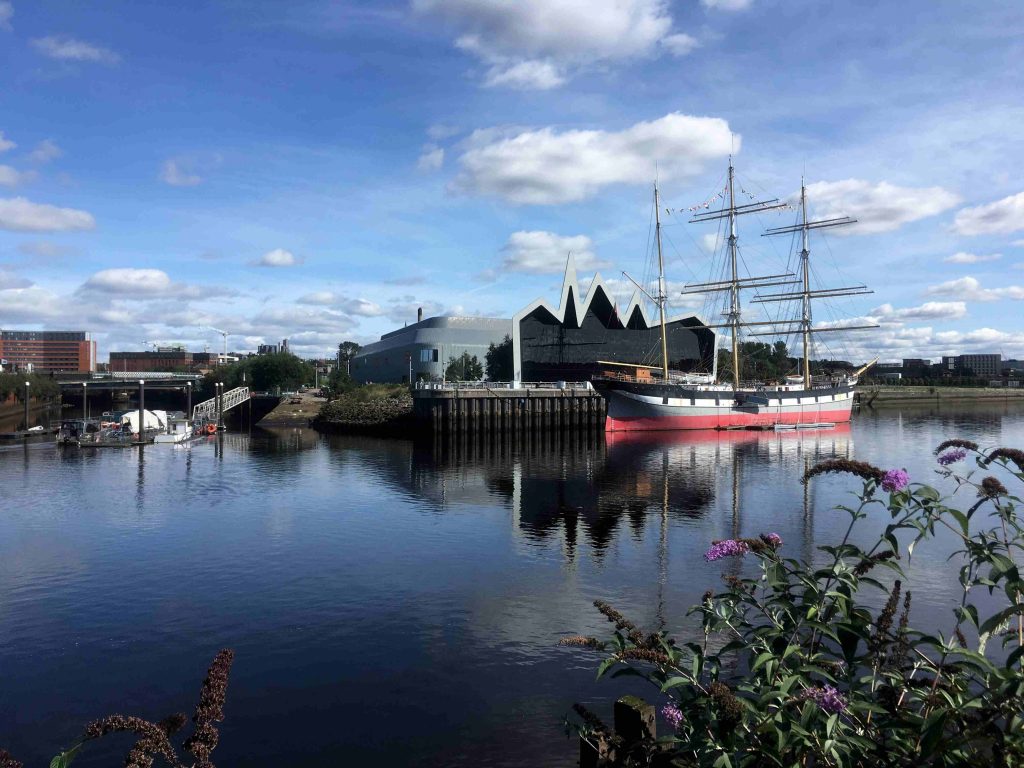
Our community base was, the aforementioned Kinning Park Complex (www.kinningparkcomplex.org/) which had closed as a local primary school, was being well used as a community centre when, in 1996, Glasgow City Council decided to evict the community user groups, close it down and sell the land. The community were outraged and, following a 55 day community sit-in and a decade of dedicated campaigning by Helen and her team, it is now an independent community space, with a focus on wellbeing, creativity and sustainability. The KPC team are committed to improving the local area. They host regular and irregular events and projects, ranging from pay-what-you-can meals to film screenings, and gardening and recycling projects. The building also holds artist studios.
The Kinning Park Complex is a truly unique community space and has recently made history again by becoming the first urban community in Scotland, pioneering and testing the efficacy of the new Community Empowerment Act. They have finally managed to use the Scottish Government’s community “right to buy” policy to buy the building and have secured both Government and Lottery cash to transform it. With a successful social enterprise cafe in the building, we contributed to their project by commissioning evening meals and packed lunches from the cafe. We also used the building for our film screenings and “meet the community” events throughout the week.
Memory of Water learning from the KPC experience was as much about the governance structures as it was about the way the building operates and there was much learning and sharing with e.g. Ormston House in Limerick.
The Programme
Tuesday 3rd September
We wanted our visiting artists to start by experiencing an overview of the upper Clyde and our hosts in helping us to do that were Dr Alan Leslie and Ingrid Shearer: archeologists and historians who hosted us in the home of Clydesdale Amateur Rowing Club (CARC)
Established in 1857, CARC is one of the oldest rowing clubs in Scotland. They are based at West Boathouse in Glasgow Green which is an A listed heritage property (incredibly, a wooden structure) currently undergoing loving rejuvenation work. The restoration of the West Boathouse Project isn’t just about a building however. The aim is to use the building as a hub for learning: to open the Clyde to everyone, enjoying the shared “social, physical and psychological benefits of being part of a diverse river community”. The club encourages learning, health, well-being and confidence – celebrating community and the heritage of the site. Ingrid Shearer is the outreach and engagement officer who is helping to link the West Boathouse with the wider community: encouraging use and ownership as it undergoes major transformation. (www.clydesdalearc.org.uk)/
The West Boathouse is built on the waterfront at Glasgow Green (en.wikipedia.org/wiki/Glasgow_Green ) which is the oldest park in Glasgow, established in the 15th century. The Green also contains Nelson’s Monument, St. Andrew’s Bridge, the People’s Palace, the McLennan Arch, Flesher’s Haugh, William Collins’ fountain, the Doulton Fountain, and the magnificent Templeton Carpet Factory which is now a business centre. As well as recreation, it has been a location of protest and congregation for Glaswegians for hundreds of years, and is used regularly to facilitate sports events, races, and music festivals.
Alan and Ingrid shared some of the history of the Clyde with us, taking us onto the water (we rowed ourselves further upstream to see the city from the river) before hiring bikes and cycling on the tow paths and Cuningar Loop to experience the River from its banks. The Cuningar Loop is a woodland park on the Clyde, in the East End of Glasgow (www.visitscotland.com/info/see-do/cuningar-loop-woodland-park-p1498501). The site was at one time a reservoir, later used for quarrying and mining, and in the 1960s as a landfill for the rubble from the demolished tenement ‘slums’ of the Gorbals area. The park is around 15 hectares and includes cycling routes and footpaths, a pathway which follows the curves of the Clyde, play facilities for children, an outdoor bouldering/climbing park, an outdoor classroom, and large areas of greenspace, as well as 15,000 trees.
On Tuesday evening we returned to our Kinning Park Complex base for a meal and a film screening where we met some of the women activists researching the history of Mary Barbour (who led the 1914 rent strikes in Govan) and watched their film “Red Skirts on the Clydeside”. Other films in the screening included the 1960’s Oscar winning “Seawards, the Great Ships” (where we gained a flavour of the scale and grandeur of Govan’s ship building hey day) Chris Leslie’s award winning haunting piece about the decline of industry in Govan (www.chrisleslie.com) and a preview of our own Jonas Mysterand’s first piece on Memory of Water: an edit of the first residency of the project, in Levadia (https://vimeo.com/357175263).
Wednesday 4th September
Wednesday morning began with Iain McGillivray of Clyde Docks Preservation Initiative hosting a “Walk to the Docks” where we heard the story of the 8 year campaign to save Govan’s iconic Graving Docks (www.cdpi.org.uk/) and the successful overturning of a plan to build 750 high rise flats on the A listed site. Clyde Docks Preservation Initiative (CDPI) is a research, networking and advocacy social enterprise, protecting and promoting maritime and industrial growth in Scotland. They are an organisation that is interested in cultural planning, education, innovation, new technologies, environmental issues, the potential for re-industrialisation, the current issues around heritage, growth, tourism and gentrification in the area. and sustainable development. Iain is the founder and executive director and the first project for CDPI was the campaign to save the Graving Docks. From the successful campaign to save the docks from high rise housing, a new trust has emerged to take forward plans for the docks leaving CDPI to expand its focus to look at the future development of the wider Clyde.
Meanwhile, Govan Docks Regeneration Trust (govandocks.wordpress.com/) moves forward with plans for the docks. GDRT is concerned with the long-term protection and development of the unique post-industrial site, which has been disused for 30 years. The Govan Graving Docks (GDRT) volunteer board are currently running a comprehensive community consultation project, exploring the priorities of the local community in relation to the docks.
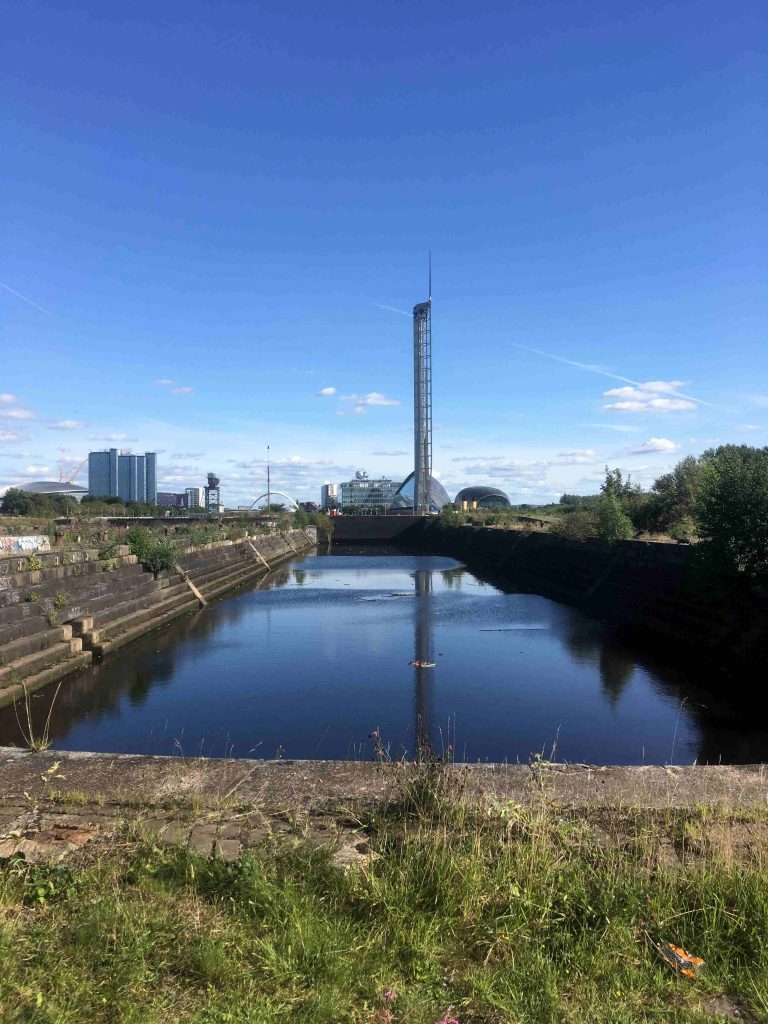
The Graving Docks campaigners have linked closely with (and learned hugely from) the North Kelvin Meadow Group. North Kelvin Meadow is a multi-use green space in the Maryhill/North Kelvinside area of Glasgow, which was officially established in 2008. Local residents opposed a housing development proposed for the site by New City Vision (the same developers who currently own Govan Graving Docks). In response to the campaign Glasgow City Council rejected the plans and did not sell the land. The community group North Kelvin Meadow Group now manage the site as a garden and public meadow/field (northkelvinmeadow.com/). Govan Docks Regeneration Trust have managed to emulate the first part of the NKM activism: they have stopped the housing development. They are now learning and exercising muscle on the second part: to acquire the land and deliver an alternative community led vision for the site.
Our next stop was the disused ex Harland and Woolff shed on Clydebrae Street (govanshed.co.uk) which is now owned by the McMillan father and son Angus and Neil as a space for rental. It is an emerging cultural hub of Govan with artists/artizan/craft workshop units in the smaller spaces and a huge space used by theatre companies, film studios as well as by local community groups for pageants. With its proximity to the Graving Docks, it is easy to see the potential of indoor/outdoor film locations coupled with industry (there is a market for dry docks in Scotland), learning, tourism and heritage.
Unit 7 of the Govan Shed is an artists’ studio complex and workshop, hidden in the centre of Govan. (www.unit7glasgow.org/index.html). With a fantastic selection of artists and craftspeople, there are always projects and exhibitions coming out of these studios. We met artist Beatrice Searle here, who’s work uses ecological and geological research to explore human connections to natural environments and landscapes. Beatrice is also a commercial stone mason. (www.beatricesearle.com/). Beatrice spoke to us about recent work and upcoming projects, as well as showing examples of her stone carving and describing technical aspects and challenges of her work. She spoke about her performance project, Learning a Stone, at Jupiter Artland.
Another unit in the Shed is rented by Glasgow Press: specialists in letterpress printing, (glasgowpress.co.uk/). It is possible that our artists will want to use printing facilities for their work when they return for the production residency in June 2020. Dan and his father are a family business who have run Glasgow Press for decades. The artists were fascinated as Dan gave us a detailed tour of the different equipment and printing methods. A big potential for artists is that they could be use these services for some aspects of their projects. The artist were also each given a beautiful, traditionally printed poster as a memento of their visit.
At the other end of Clydebrae Street and butting onto the Govan Shed is Riverside Hall: a very well used and long standing community centre for Govan, holding clubs, classes, groups and community meals. (www.getintogovan.com/projects/riverside-hall/).
Run for the past three decades by the indomitable community activist, Davy Paterson, they also host the local Govan East Community Council meetings. Davy, from the Riverside Hall, talked with the artists about the history of the Hall, the current issues in Govan and the need for community centres in Glasgow. He also gave information on the wide range of groups and clubs the hall facilitates and the impact these have. Riverside Hall also has a community garden. It is set on an important location, where the repurposed and well-loved post-industrial Clydebrae St meets a 1960s housing estate which replaced the old Harland and Wolff shipyards.
With lunch back at the Kinning Park Centre, we spent the afternoon sharing food and experiences with various local artists like Gaynor Milne (www.linkedin.com/in/gaynor-milne-78b73588/) Paul MacAlinden (www.glasgowbarons.com) and Richard Walker (richardwalker.info/CV) as well as a huge variety of community organisations including:
Govan HELP
- A very active family education support project and charity, they are committed to improving the opportunities and life skills of children and their families/carers in Govan through a range of activities and classes. They were established in 1996.
Govan Community Boxing Club
A relatively new boxing club in Govan, running classes for children and adults, encouraging sport and wellbeing.
Govan Community Project
Established as an organisation to help newly arrived asylum seekers, the group have developed into a charity which helps a wide range of communities in Govan. Their activities include English classes, providing information and advocacy, running cultural events, food distribution projects and interpreting services. They are advocates of equal rights and cross-cultural understanding.
www.govancommunityproject.org.uk/
Gilded Lily
Through advice, learning, workshop groups, and raising awareness, Gilded Lily support women in the areas of confidence, creativity, employment and enterprise. They run a diverse range of workshops regularly. They also have a mentoring project to link local women.
Make Do and Grow
Make Do and Grow helps families with children aged 3-12 through creatively re-using and recycling. They develop creative ideas for waste-reduction from a young age, empowering families and building community through classes, play sessions, and selling used clothing and toys for children. www.makedogrow.co.uk/
Our Wednesday evening ended with a tour of the Kinning Park Complex (KPC) led by Martin Avila who has been driving the centre development project for the last few years. Martin told us the whole heroic story of activism, struggle, failures and successes up to the present day where the centre is poised to undergo major transformation. We visited the studio of Richard Walker in KPC (richardwalker.info/CV) who has been a stalwart of the campaign from the outset and has helped to drive the process to victory. The main question from our team was what will happen to artists like Richard who have been so key to the process. Will there be space for them in the swanky new refurbished building? The jury seems to be out on that as economic necessity will dictate a level of rental income required to keep the building viable going forward.
So the question remains: how can artists and the communities they are serving, work in declined urban environments, help to raise the values but not become subject to gentrification? Are the artists simply part of the problem and are buildings like KPC going to become inaccessible to the communities who fought for them?
Martin and his team are of course determined that will never happen with Kinning Park Complex.
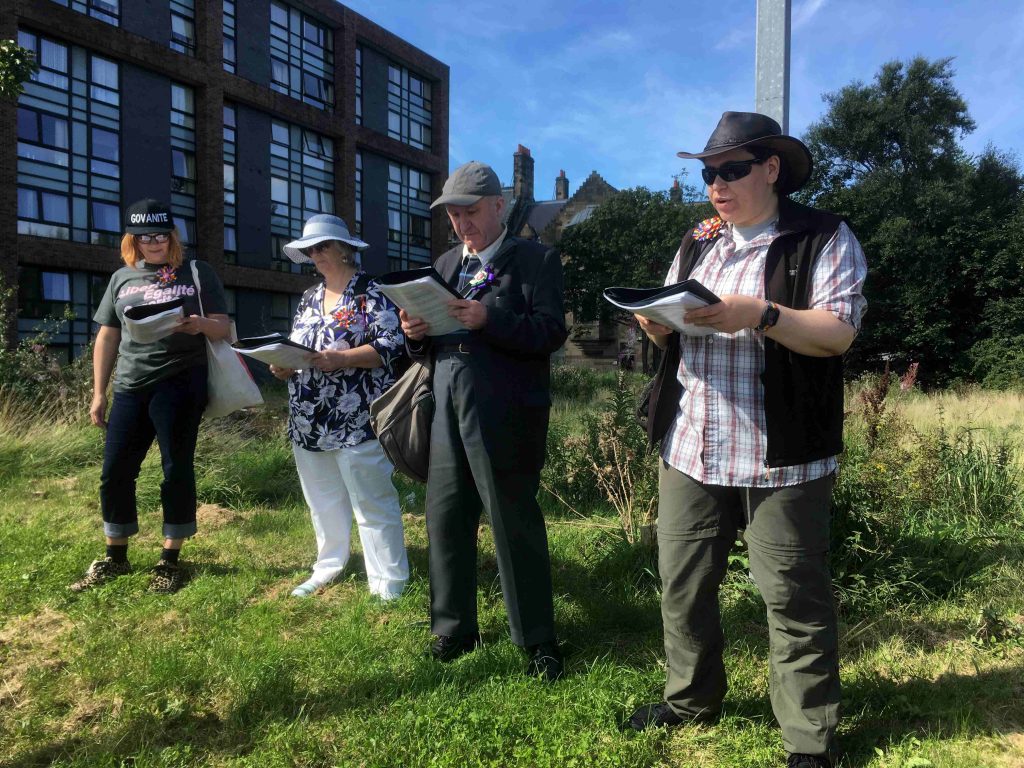
Thursday 5th September
Thursday morning began with a walk through Elder Park led by Scott Martin from the Friends of Elder Park (friendsofelderpark.wordpress.com/). Elder Park was gifted to the people of Govan in 1885 by Lady Isabella Elder, the wife of a shipbuilding magnate. Her commitment was to the health and education of the shipyard workers and their families and the deeds explicitly state what the park should be used for in support of the wellbeing of local people. A statue of the lady herself oversees the park and ensures her legacy is respected. In 2013, worried that the ethos of Isabella Elder may be eroded by Glasgow City Council’s competing economic agendas, Friends of Elder Park was established as a voluntary community organisation to protect the park as a vital green space for the area of Govan. The park provides activities and facilities, as well as education and community development. Govan’s beautiful public library, Elder Park Library, is situated within the park.
Also within Elder Park (and in keeping with Lady Elders aspirations) Moogety Garden, supports community based learning and growing. Run by Urban roots, another local voluntary organisation, Moogety Garden and Moogety Food Hub support and teach gardening and healthy eating in Govan (elderpark.org/your-community/projects/moogety-foods-moogety-food-hub-moogety-garden/). They run community-focused activities including music, games and temporary cafes. They hold free cookery courses in the Moogety Hub, as well community meals and a bread club.
From Elder Park, we crossed Govan Road to Fairfield Heritage (www.fairfieldgovan.co.uk/heritage), a shipbuilding museum and research centre, established by volunteers and Govan Workspace. Govan Workspace is a social enterprise, set up 1981 to create employment in the area. They have developed several enterprise centres throughout Govan with an ethos of encouraging local start ups and businesses. In 2009 they purchased the derelict Fairfield Shipyard Offices so as to reestablish commercial life in Govan’s run-down town centre. Fairfield Heritage is set in this A-listed building where interactive displays document the rise and fall of shipbuilding on the River Clyde.
Our next stop was Govan Old Church to see the Govan Stones. Built on one of Europe’s earliest Christian sites in Europe, Govan Old Church is an important spiritual, historical and cultural site. During the 1980s, an archaeological community dig in the churchyard uncovered medieaval carved stones and crosses as well as huge ancient stone forms shaped like upturned boats which are now recognised as the most significant collection of Viking Hogback stones in the world. (www.thegovanstones.org.uk/).
The church is still a place of worship run by a volunteer Kirk Session and serving both a church of Scotland and Russian Orthodox congregation but in the early 2000’s, a trust was established to take custodianship of the stones and develop the church as a visitor attraction. Many of the existing congregation took positions on the new trust and the church now holds the collection of significant stones, including the rare hogback, Viking stones dating from 9th-11th century, the sarcophagus of (possibly) St Constantine and many other Celtic treasures.
Our journey continued across the River Clyde on Govan’s free ferry that runs during the summer, taking people between Govan and Partick – two areas which were historically one borough. Water Row has been a fordable crossing point since Neolithic times. When the Clyde was deepened for shipbuilding, the ferry was established. Partly due to the underground train system, the ferry was discontinued. However, after a huge community campaign, the ferry has been re-established and is again an asset to Govan, unique within Glasgow (www.bbc.co.uk/news/uk-scotland-scotland-business-13841775)
With a base in a refurbished portakabin on the pontoon at the mouth of the River Kelvin (where the fordable crossing used to be) is Glasgow Coastal Rowing Club (rowglasgow.org.uk/)
Glasgow Coastal Rowing Club meets and rows regularly from their headquarters at the pontoon where the River Kelvin meets the Clyde. With a committee of volunteers and members (including the Lord Provost of Glasgow!) they have set out to encourage coastal rowing and to teach skiff and rivercraft handling. Their boats are a common and exciting sight from the Govan waterfront.

The pontoon was established to serve the Riverside Museum. Designed by renowned architect Zaha Hadid, the Riverside Museum of transport opened in 2011. It also facilitates arts, music, education, and hosts both the annual Clydebuilt Festival and the festival of Showpeople culture at Christmas time. The museum, built on the A. & J. Inglis Shipyard site at Glasgow Harbour, where the rivers Kelvin and Clyde meet (www.clydewaterfront.com/projects/greater-govan–glasgow-harbour/leisure/riverside_museum) has won accolades for its popular programme: attracting huge visitor number since opening and employing volunteer guides who are able to share lived experiences with the visitors. Our guide was retired fireman, Bob James who was able to show us the actual fire engine he drove and uniform he wore when he worked for the fire brigade. (https://en.wikipedia.org/wiki/Riverside_Museum)
Berthed in front of the Riverside Museum and providing a fabulous visual effect from the opposite bank is the Glenlee or ‘Tall Ship’: a beautifully restored three masted barque which is now another major visitor attraction. Essentially a rusting hull, and set for dereliction, the Glenlee was recovered from Seville, Spain, in 1990 and restored by the Clyde Maritime Trust (thetallship.com/index.aspx)
Back across on the Govan side of the Clyde, the GalGael Trust is a must for visiting. (www.galgael.org/). GalGael is a well-established community organisation in Govan which is made up of a charity and a social enterprise. They run a woodworking workshop, which includes boatbuilding. They also run a Thursday night community meal. Their vision and purpose is to “stand against scarcity, loneliness and violence. “We stand for compassion, justice and humanity.” We joined the GalGael on Thursday evening for a tour of their workshops and wonderful meal with a ceilidh (everyone contributing a song to the occasion)
Friday 6th September
Memory of Water’s first international urban lab in Govan (the second one is scheduled for June 2020) took place in Film City which is located in the magnificent (and fairly newly refurbished) old Govan Town Hall. The organisation running the building now rents offices, production and post-production spaces to creative media companies (www.filmcityglasgow.com/). Our urban lab was a hugely successful full day of exploration of the main themes of Memory of Water.
The overall theme of the Lab was the role of participatory arts practice and artistic interventionism in future planning for post-industrial heritage zones in Europe.
We opened our deliberations with a welcome to Govan from the local Green party councillor, Allan Young who praised the amazing groups, people and places we had visited during the week. He, like us, is amazed at the wealth of resources Govan has but, like us, is anxious as to why they are not being better used sustainably for the good of Govan and her people.
Our lab was organised as a series of panel discussions with our first panel exploring heritage (tangible and intangible) and the barriers to how it is being respected/incorporated in a cultural planning approach. Dr Alan Leslie set the Scottish national contextual scene with a provocation around the abundance of heritage and history (deeply appreciated by Govanites) and posed questions about why this heritage is not more respected and used to deliver jobs and training for the area. He also flagged some hints around land ownership, power and competing agendas that could offer some answers.
Dr tsBeall focused her presentation on the issue of Govan’s Showman community. Showmen have been based in Govan for centuries. At one time there were 17 yards in the area but now there are only two. The two remaining yards are on the riverfront at Water Row and the resident families are under constant threat of eviction as plans take shape for new housing developments and a bridge joining the two banks of the Clyde. “Show people are the last permissible cultural group to suffer discrimination” she asserts. The show people are much loved locally and it seems staggering that decision makers can’t see the potential of the contribution show families could make to future plans. Councillor Allan Young agreed and has tried to fight their corner with little success so far.
Angus Hardie from Local People Leading led us through the maze of Scottish Government policy in 2019 which has placed major emphasis on community empowerment, the community right-to-buy and the community right to enforce sale. We should be living in the perfect policy environment in Scotland right now, to support Showmen as well as the visions and alternative futures that artists support communities to develop. There are very few examples in urban Scotland, however, with Kinning Park Complex (KPC) being one notable exception.
Our urban lab panel discussion then explored why all of this is the case and what are the problems, issues and barriers. We also reminded ourselves of the European Context. As we progress through our Memory of Water learning journey we are discovering that in many European post-industrial cities, problems of gentrification and loss of memory are shared issues. There are unique sets of circumstances in Govan, Gdansk, Gothenburg, Ostend, Levadia and Limerick but in all cases there are tensions between what artists working with local people are able to imagine for their places and what other key stakeholders envisage. In the discussion, our artists shared their experiences in other cities
As the opportunity of this residency and urban lab in Govan was for artists to share experiences and practice: learning from each other and growing possibilities for future work, our second panel focussed on the cultural policy of the city of Glasgow (Katie Duffy from Glasgow Life helped us with this) and in particular the role of culture and artists in city/neighbourhood planning. Katie introduced the current ambitious residency project in every neighbourhood of the city that Glasgow is running. We then heard from Alex Wilde (www.alexwilde.info) who is one of those artists in residence. Alex shared her practice and her experience as well as what she sees as the problems, issues and barriers to taking local aspiration from vision to activism and delivery. She is the chair of one such project in Govanhill where this has actually happened: Govanhill Baths Trust.
The community of Govanhill is diverse and with high indices of multiple depravation (including ill health) so the existence of the community swimming baths facility was hugely important. When the City Council decided to close the baths to save money, a community group staged a sit in for several years. Like the Kinning Park Complex, they established a volunteer committee and governance structure coupled with creative and cultural activities (artistic interventionism, an annual cultural festival and much more) that continually raised the profile and aspirations, keeping the focus on returning the baths to the community to be a support and contribution locally as well as delivering ownership of the building into local hands. There have been huge successes and like the Kinning Park Complex, they have almost broken through to success.
Our discussion following panel two presentations was wide ranging and honest in its identification of the perceived limitations: the gaps between community vision and the reality on the ground. In particular our question was: “why (when policies at government level are so favourable) does it have to be such a huge, prolonged and exhausting struggle? One key question emerging concerned the nature of the City’s interventionism and artist residency programme: is the context arts development (designed to promote arts activity and deliver arts services where there are missings) or is it cultural planning (in other words, designed to facilitate local people in the process of community empowerment)?
Panel three of our urban lab shifted our focus to artists working on waterfronts all over Scotland and we were joined (virtually) by the hugely respected and experienced Minty Donald (www.gla.ac.uk/schools/cca/staff/mintydonald) (performanceecologyheritage.wordpress.com/portfolio/minty-donald/) and Nick Millar (www.untitledprojects.co.uk/collaborators/nick-millar). They have been “guddling” (an old Scots’ word for messing about in water) all over Europe for almost a decade, creatively exploring the social and economic aspects of various rivers and their people.
Our final presenter within this panel was Mark Zygadio who shared his work on the River Nith in Dumfries, including his latest work called Water Organ (www.youtube.com/watch?v=-3-YM4PrIlc). Along with artists at the Stove Network (www.thestove.org) Mark has managed to refocus energy on the river, attract people to celebrate it with an annual festival and open dialogue around how best to use it sustainably in a future beset with problems like climate change.
Our open discussion at the end of this panel presentation marvelled at the real dialogue transformation that has happened in all of our examples on the ground: not least in Govan where interventions from artist and activists has really transformed assumptions about the future of the Graving Docks. The 750 high rise homes will definitely not be built and we are now able to turn the conversation to what’s next.
If not housing, then what?
Our final urban lab panel session gave the platform to our own Memory of Water artists starting with artistic director, Mary Conlon, who gave us an overview of the work and findings so far. The variety of practice and approaches is diverse and rich with each artist committed, passionate and skilled at working in community settings.
Iwona Zajac (Poland) presented her work in the Shipyard area of Gdansk as well as other work with women’s issues and political interventionism.
Siefried Wynk (Belgium) presented his work in Levadia and shared his enthusiasm about how working in other European cities is influencing his own practice
tsBeall (Scotland) presented her work allowing the normally hidden voices and histories (like women working in the shipyards, fighting for rent rights and the plight of the showpeople) to be heard.
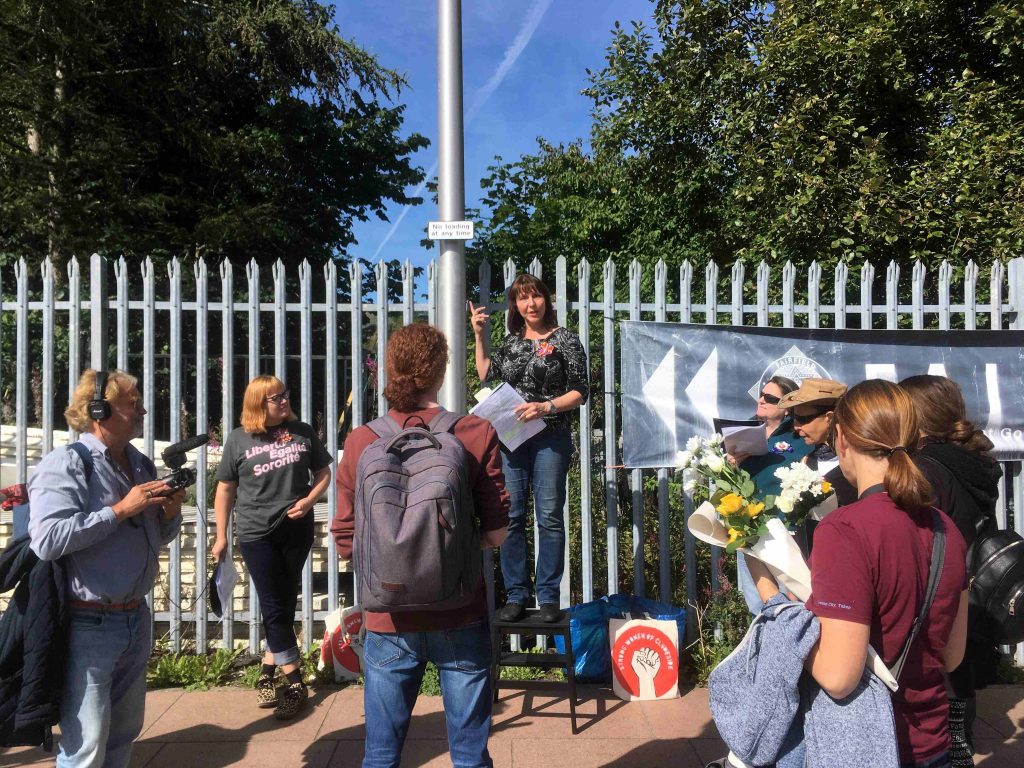
Ira Brami (Greece) has only just joined the team as she replaces the original Greek artist who had to leave the project but already, she is one of the team and representing a huge contribution.
Mary Conroy (Ireland) presented her work working with rivers and natural habitats mainly in Ireland. Again, Mary was excited to share with other European artists with varied practice.
Finally, we heard from Jonas Mystrand (Sweden) sharing his Gothenburg shipyard virtual reality, the task of filming a flavour of activities on the Memory of Water project and of course, his first filmed piece from Levadia (https://vimeo.com/357175263).
On the evening of Friday the 6th September we were afforded a great honour as we were hosted by the Lord Provost of Glasgow, Eva Bolander who is also Swedish and is taking a personal interest in our Memory of Water project. The City of Glasgow gave our European guests an official Civic Reception in the magnificent City Chambers where the honoured guests included dignitaries from the City Council and the Merchants House of Glasgow as well as around 40 participants who had participated in and hosted activities with us during the week or in the lead up to the project. Also joining us were some of our partners from Clyde Docks, Govan Docks and Ferguson Marine the shipbuilders in Port Glasgow who have an interest in reestablishing Govan Graving Docks as dry docks.
Saturday 7th September
The morning of Saturday 7th September was our evaluation meeting in our home base flat. Over a delicious traditional Scottish fried brunch, the artists shared their initial responses to what they have seen in Govan and the ideas that are beginning to take shape towards the production week in June 2020. There is tangible excitement at the passion, energy and commitment they have witnessed amongst the people and community organisations they have met here. They are blown away by the hospitality and the welcome and they are struck by the similarities between the situation here and the situation in other parts of Europe.
The Fablevision team are left with key tasks to follow up. Siegfried Vynk has identified the wall at the city centre end of the Shed in Clydebrae Street as his preferred site for a mural (possibly re creating the Govan cranes which we have lost, unlike Gdansk who now have a heritage preservation order on their cranes). He would like to work with some of the young people/user groups of the nearby Riverside Halls. Our immediate tasks therefore are to follow up with the owners of the Shed to seek permission and support as well as Davy Paterson at the Riverside Halls.
Iwona Zajak has identified a low wall within the Graving Docks site which is visible from the Govan road that she would like to use for her piece. This will be a delicate negotiation with the owners of the Graving Docks site, Harry O’Donnell at New City Vision. Ira Brami from Levadia, Greece is thinking of a project involving schools, puppets and the coastal rowing club who could potentially take the puppets up river on boats and Mary Conroy from Limerick in Ireland is thinking Moogety Garden could be her key collaborators.
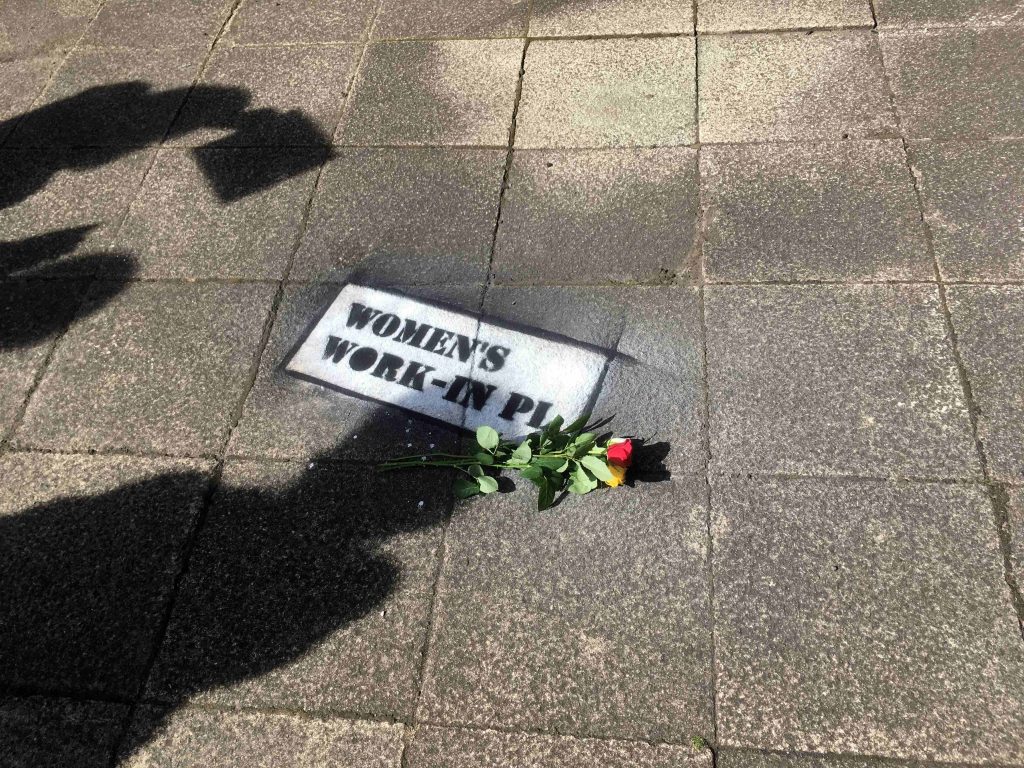
All the artists would ideally like to have access to a studio space in Clydebrae Street to use as a base for their week in June. The Fablevision team will therefore need to follow up with Beatrice or some of the existing tenants to see if its possible to allocate them a small space somewhere in the Shed area.
Our final shared activity on Saturday was joining tsBeall and the Strong Women of the Clydeside team on one of their celebrated art walks. We walked in the footsteps of Mary Barbour, Isabella Elder, Helen Kyle and others: visiting the key spaces and places associated with their memories and achievements. At each site, red roses and chalked tributes were left. The SWaC team have been delivering these art walks for several years now. They are extremely polished and engaging: a very fitting tribute to the elders of Govan.
Most of our guests had headed for airports and train stations by Saturday evening but those of us remaining enjoyed a final meal together in the Amethyst: a hostelry that had been a traditional ‘spit and sawdust’ Govan working mens pub named after the famous battleship Amethyst that was built in the Linthouse shipyard. It has been transformed by artist and daughter of the owner and now a cultural hub with music and quizz nights, exhibition space (which is offered to our artists when they return in June) and live music.
Conclusions and learning
The learning has only just begun from our process in Govan but already there are some emerging findings:
– The threat of gentrification is as big a threat in Govan as it is in other European cities. Already, much of the Clyde has been built on with high rise homes and loss of industrial infrastructure. There are a few locations left, with Govan Graving Docks being one of them. What will happen to them and can the artistic interventionism make any real, tangible impact.
– We noticed the dialogue about arts and culture tends to be focused on “arts development” rather than cultural planning with Glasgow City Council officers and we wonder how we can influence that thinking. Without full distinction of the differences, it will remain a struggle for the Govan Hill Baths and the Kinning Park Complexes as well as the Govan Graving Docks.
– The question of Governance is a fascinating area that is opening up from our Govan deliberations. There is a big focus on artist collaboratives and artist collectives across Europe in the 21st Century. However, it seems to be the structure that has both artists and local people in the management and driving seats that have the most power and sustainability.
These are just three of the key themes that are emerging from our initial thinking. All themes to be explored further and to bring to our thinking when we next meet in Gdansk, Poland in October.
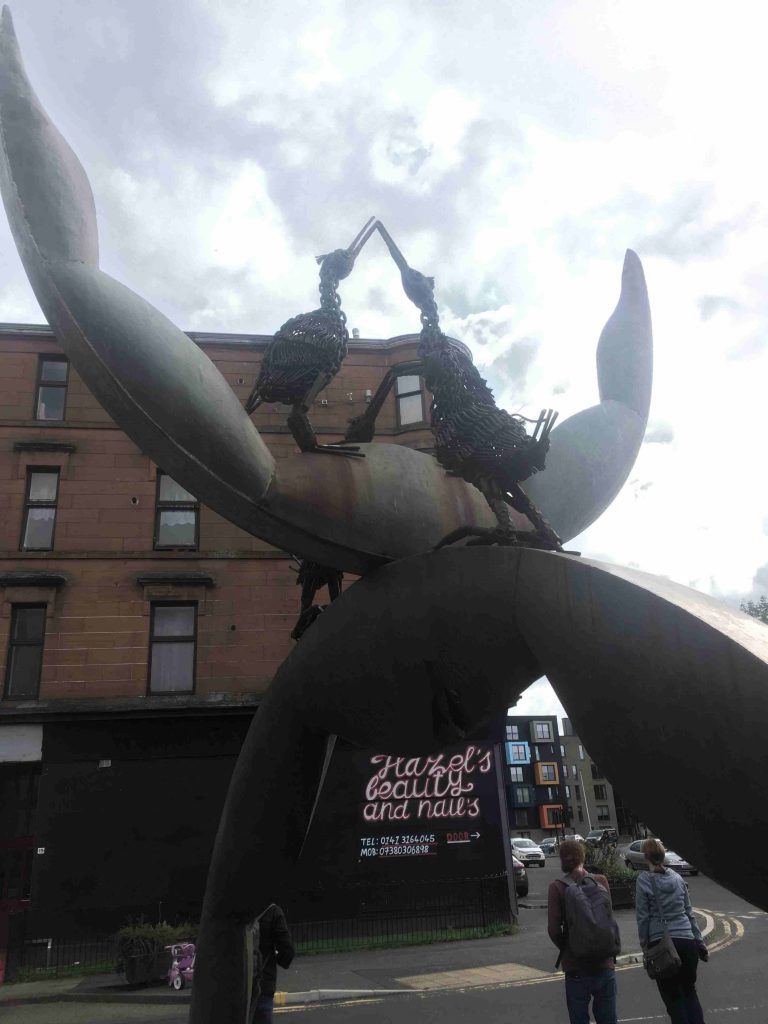
The Legacy
Already, in Govan, the ripple effects from being part of a high profile collaborative European project are being felt. Our project has been mentioned in two national news letters: Local People Leading (edited by Angus Hardie who contributed to our Urban Lab) ran a piece on the impact of artists in communities when they are working WITH communities inspired by his experience in Govan. The Social Enterprise network linking organisations focussed on Health and Wellbeing ran a piece on our interventions with an inquiry about the impact this kind of creative and cultural activity has on both mental and physical health.
Finally, and with great excitement, we are delighted to have been invited to exhibit the initial outputs from Memory of Water in the Scottish Parliament during the return week in June 2020. This is on the one hand a huge opportunity and on the other, a nerve wracking prospect as we need to capitalise on the possibilities, we need to create something with impact, quality and outputs and we need to inspire debate around it in the parliament.
These topics will be subjects of our deliberations in our planning meetings going forward.
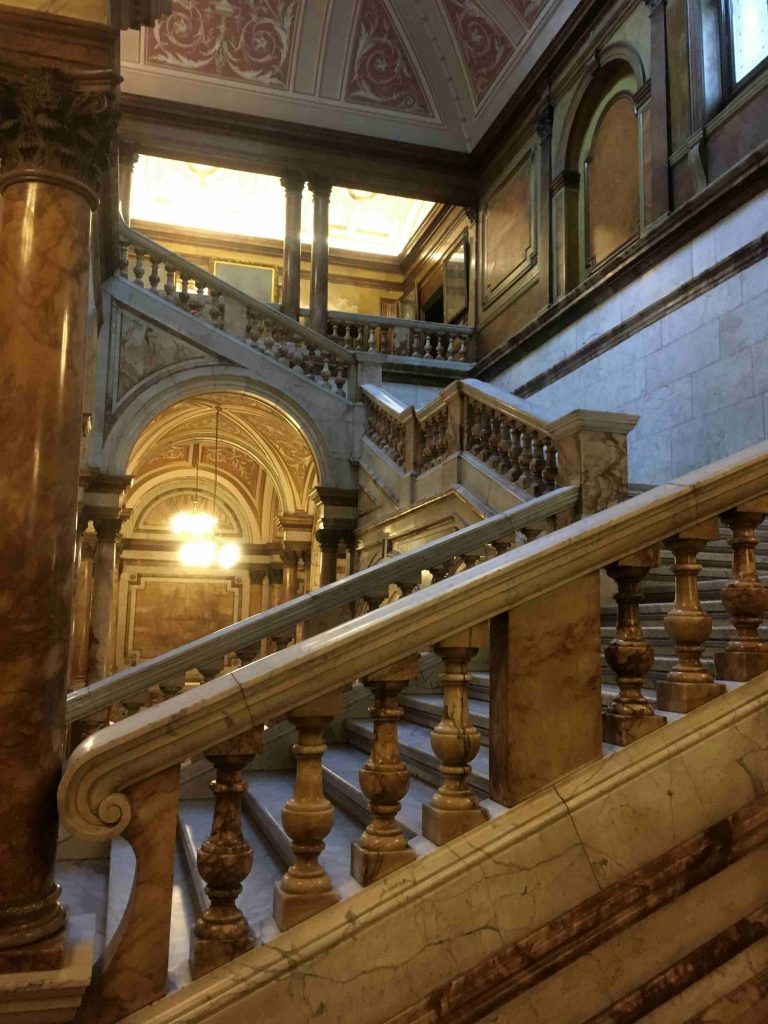
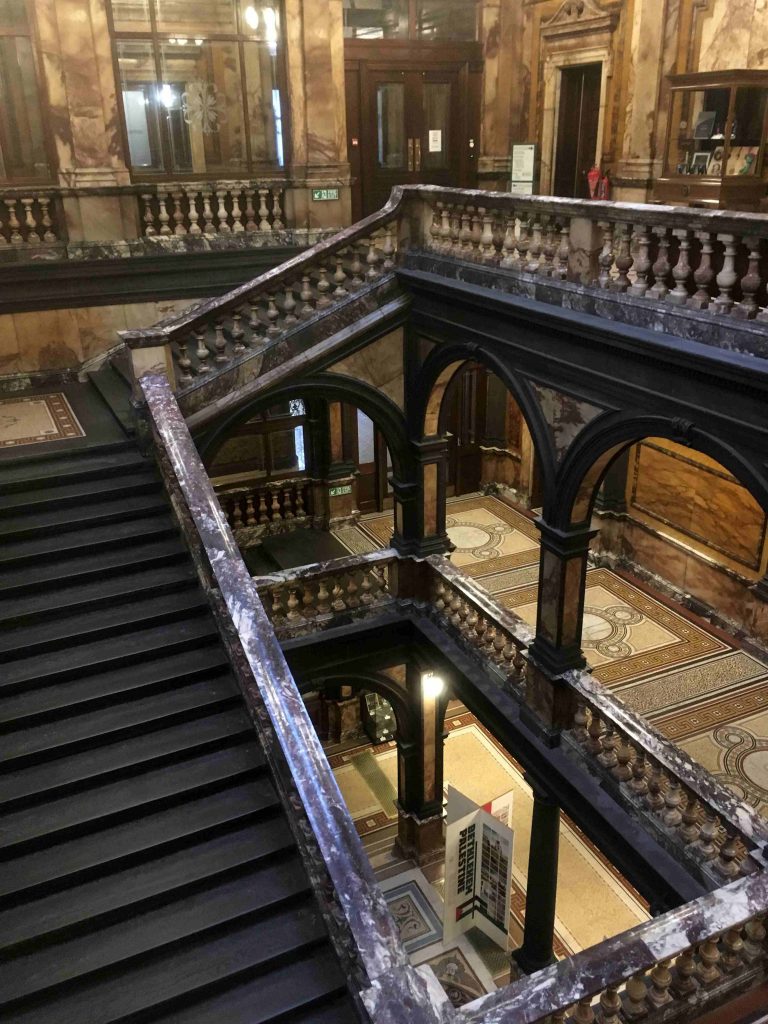
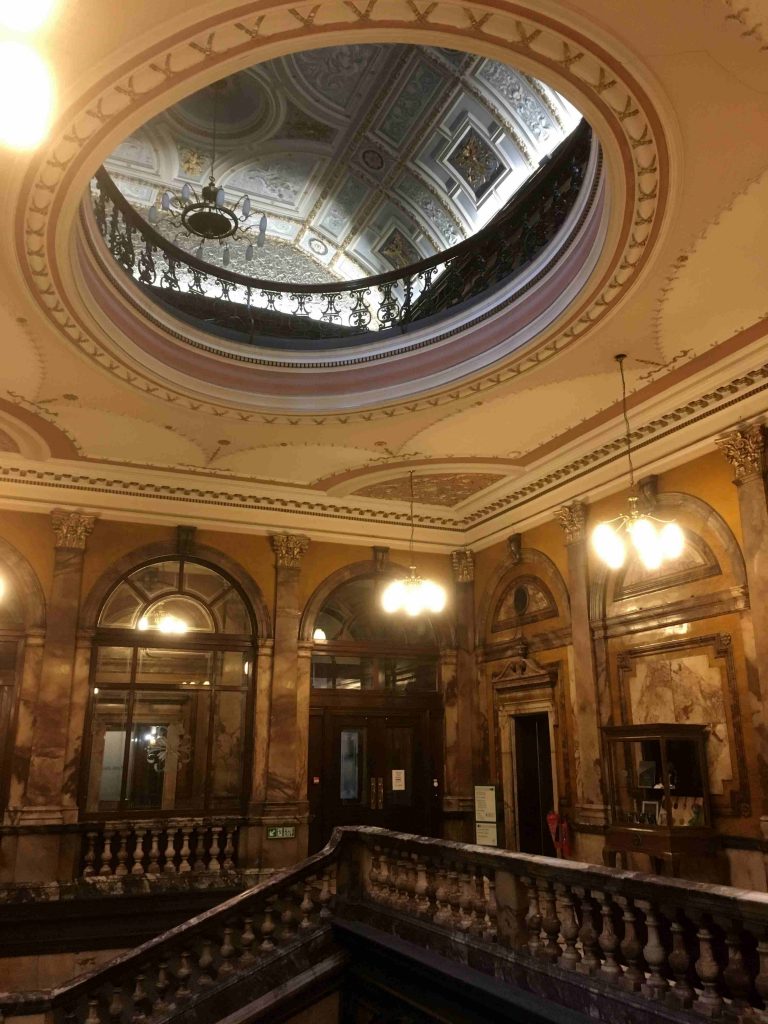
Govan: Marking the Traces
Govan has both prehistoric and historic roots. The River Clyde flowing through its midst was essential to its development. At the confluence of the rivers Kelvin and Clyde, Govan was always an important fording point. Later it was a ferry route (after the river was dredged and embanked to allow ocean-going ships to dock in the heart of the city). Further down river was Merlin’s ford, whose mythologically-inspired name takes us into another era when Govan was part of the Brythonic Kingdom of Strathclyde (5th century AD) which fought the Vikings for control of this vital trade route and meeting point.
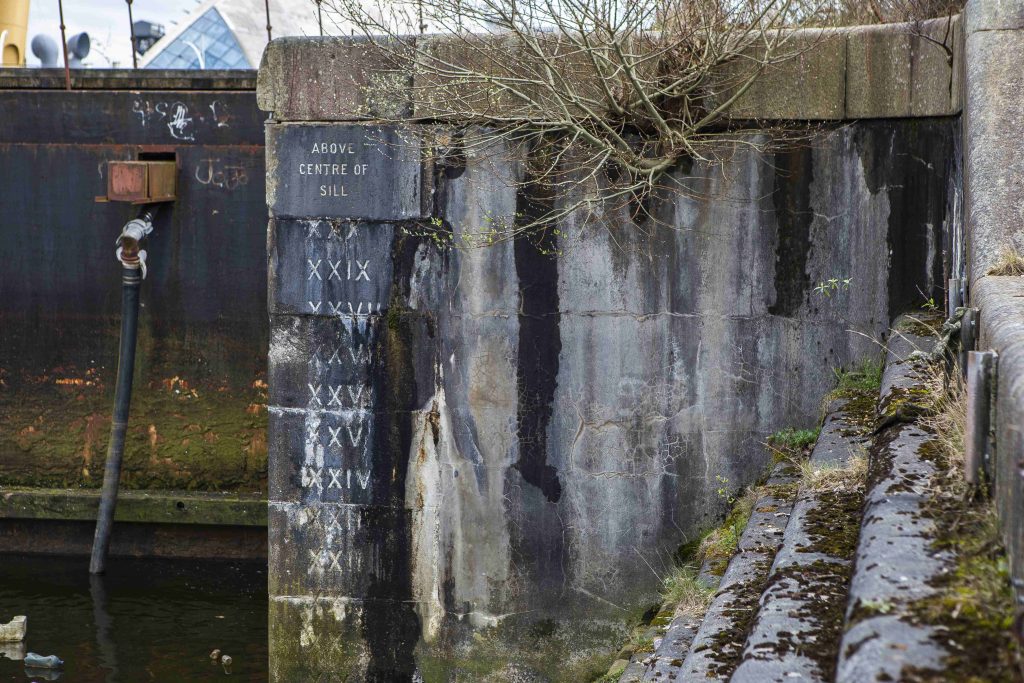
Traces of this time, aside from the hogback tombs in Govan Old Church (Anglo-Scandinavian in style); old illustrations of the man-made Doomster Hill and pictographic references on maps (e.g. Blaues’s dating from 1654, which shows Govan as a palisaded community next to a church), were swept away by successive periods of industrialisation. Weaving, which had hitherto been the staple industry of the area, was replaced by shipbuilding and heavy engineering from the 18th century onwards.
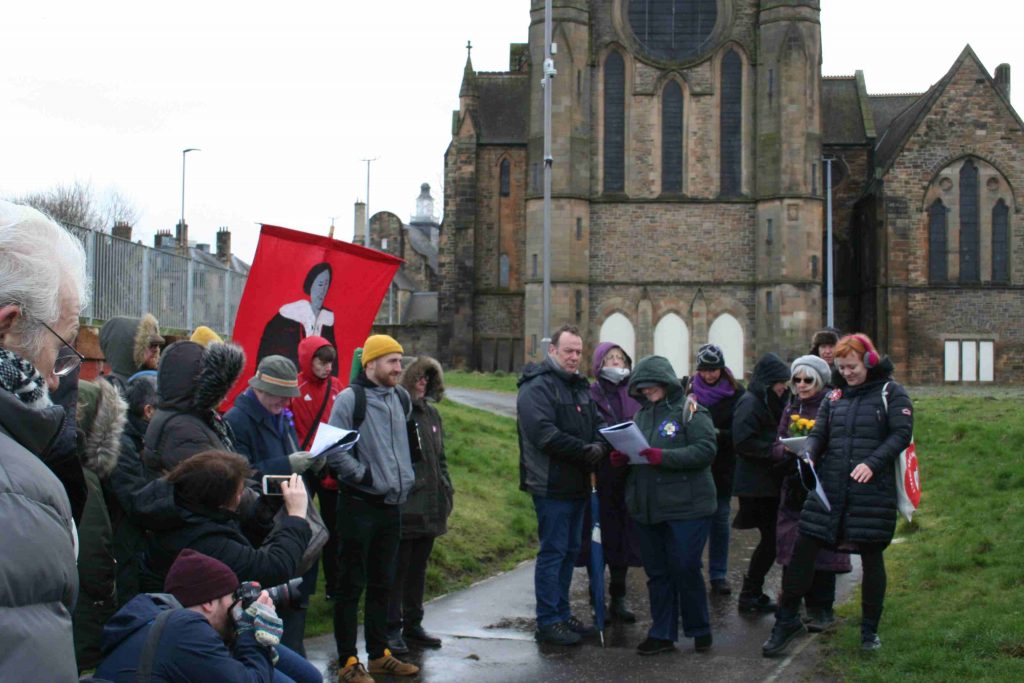
From this period onward Govan and the Clyde provided the market and merchant tonnage that sustained the Triangular Trade, the British Empire (mercantile and military) as well as providing the iron and steel for two monumentally destructive world wars. After resurgence in activity immediately post-war, by the 1970s – the time of the Upper Clyde Shipbuilders’ work-in – the days of shipbuilding on the river started to wane as antiquated work practices and cheap competition from Japan, South Korea and elsewhere destroyed its competitive advantage. The place that had played such an important role in the transport of world trade was now relegated to building and maintaining capital ships for one client – HM’s Royal Navy.
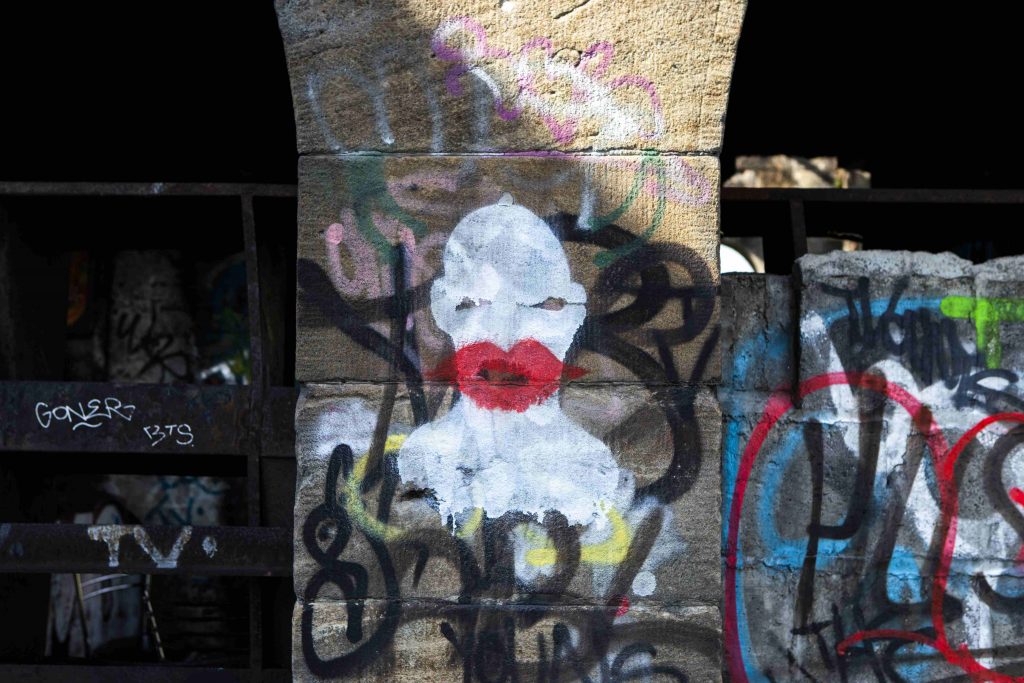
The Presence of Absence
Govan’s recurring story is one of birth-death-rebirth often characterised by the wholesale obliteration of what went before. The morphology of the riverside walk (indented to reflect the location of Harland and Wolff’s slipways) and isolated fragments of rail lines or machinery, are sometimes the only clues as to what was once there. The one constant in Govan’s history – subject to some modifications over the years – has been the River Clyde, our Clutha – the reason that Govan exists at all.
The artist residency week during 2nd-8th September, will explore how Govan and Glasgow-based artists can work in and with the local community to imagine and instigate a new narrative for post-industrial regeneration. Artists from Gdansk, Gothenburg, Levadia, Limerick and Ostend will attend to observe and interpret; they will return in June 2020 to deliver their ideas in practice. An urban lab discussion, which will involve local people, artists and policymakers, will be held on Friday, 6th September, in Film City, Govan.
Throughout the week the visiting artists will be liaising with community-based artists, organisations and businesses such as Kinning Park Complex, Fairfield Heritage, Govan Stones/Govan Old Church, Film City and Govan HELP. Ingrid Shearer will give a tutored tour of the Clyde which explores its past, present and imagined future from the water and the riverbank.
They will also visit the Mitchell Library archive and attend a civic reception at Glasgow City Chambers hosted by the Lord Provost, Eva Bolander.
At the heart of the project – and what underpins it – is how power and engagement can be invested in communities to bring about change and mesh with the Scottish Government’s policies for local community empowerment. Part of this means not just engagement but ownership.
